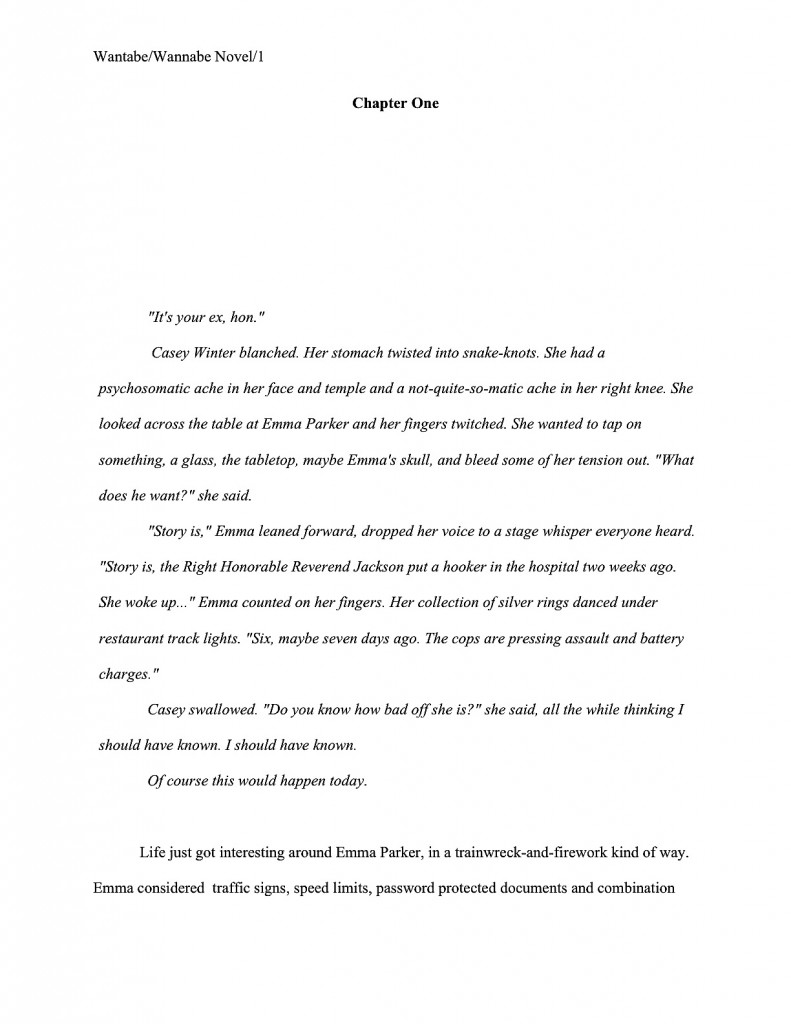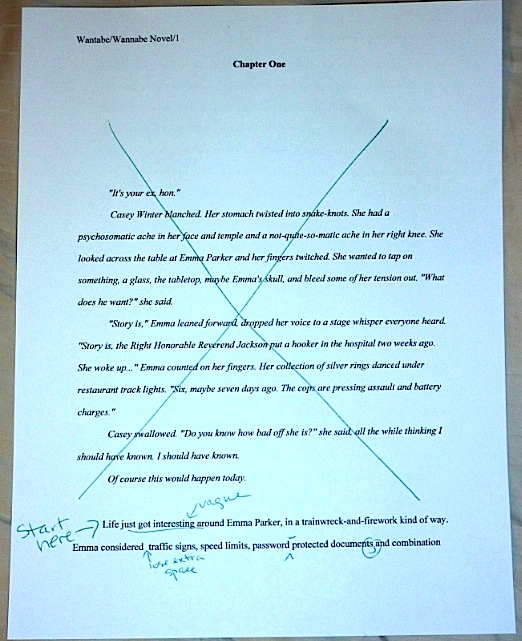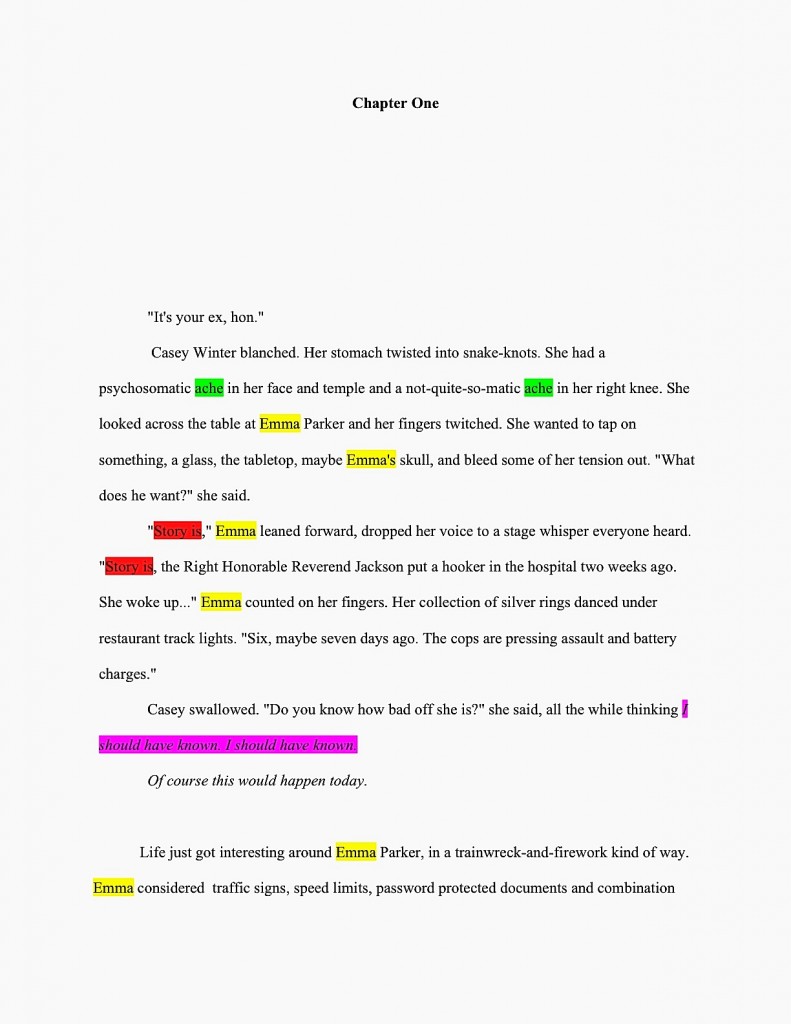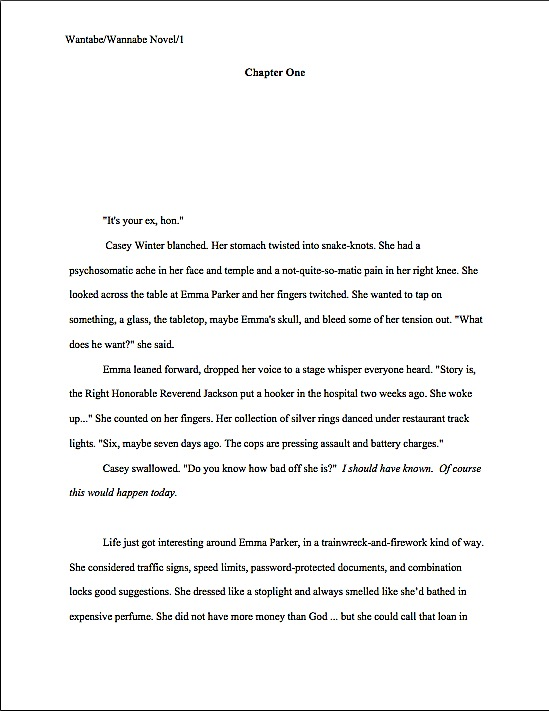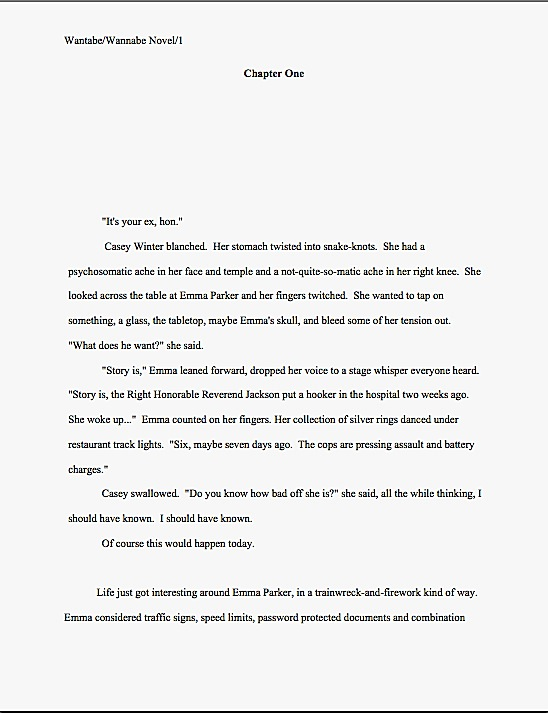
A quick reminder before we begin today: entries for the Author! Author!/WHISPER Great First Page Made Even Better Contest must be in by midnight in your time zone on May 24th — or, as we like to call around here, the point at which next Monday becomes next Tuesday. The exceptionally easy-to-follow rules may be found here.
I’m hoping that many of you will enter the first pages of your manuscripts, but I’d especially like to encourage those of you who write YA to seize this opportunity: the lucky winners of the YA category will win a first-page critique by no less a storytelling-for-youth authority than YA author Phoebe Kitanidis. I’m excited about judging in the adult category myself, of course, but I’m also really looking forward to hearing her insights on your work!
Okay, that’s enough contest promotion the nonce. Let’s get back to work.
All this week, I’ve been taking a fine-tooth comb, a magnifying glass, and a huge grain of salt to a real, live reader’s real, live first page, pointing out the nit-picks, large and small, that might cause our old pal, Millicent the agency screener, to become distracted from the inherent beauty of the writing, originality of the story, or any other selling point a writer might wish her to notice instead. As those of you who have been following this series may have noted with alarm, I’ve been talking for three days straight about potential sources of distraction in what is, frankly, a page 1 that would not have raised most readers’ eyebrows in the slightest.
Just in case you haven’t been keeping score, Millie’s cumulative remarks would have looked like this, had she been noting them on the manuscript page:
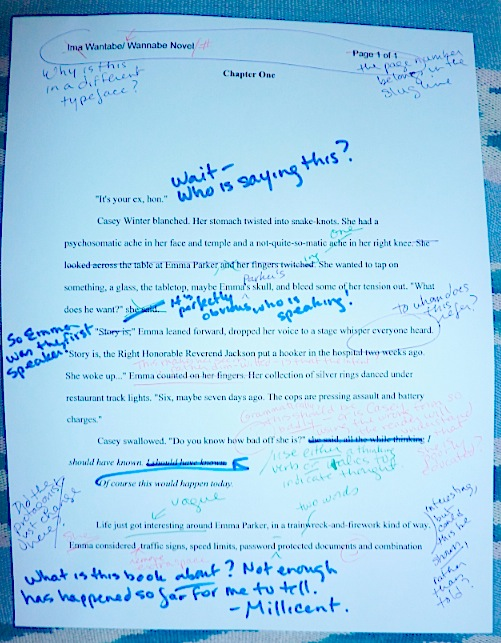
That’s not an unusually high level of feedback for professional critique, by the way: the pros read closely. While some writers might find facing that level of scrutiny a trifle intimidating, jumping on every last little manuscript error is considered perfectly normal amongst agents and editors. Why, they reason, would a good writer want not to know how to improve her manuscript?
In fact, extremely nit-picky feedback is considered indicative of respect in publishing circles: trust me, they don’t bother to jump all over manuscripts that they do not believe to be worthy of publication.
The moral, lest the combination of the image and that last insight not have driven it home with sufficient force: despite the fact that it’s Millicent’s job to screen submissions in order to find exciting stories and fresh literary talent, it’s also her job to read manuscripts critically. Many submissions (and contest entries, come to think of it) get knocked out of consideration not because of a single mistake, but due to an array of small, avoidable missteps.
What practical lesson might we derive from that? Perhaps that it behooves a writer (or literary contest entrant) to scan his manuscript as closely as Millicent would before submitting it, rather than assuming — as most aspiring writers do — that an agent seriously interested in literature would readily forgive technical mistakes, reading ten, twenty, a hundred pages before deciding whether this is a book she wants to represent.
But Millie is not paid to read with a charitable eye, nor should she; she’s well aware that if anything, her boss is more likely to reject a manuscript on technicalities than she is. (Yes, really — it’s significantly less time-consuming to represent a client whose self-editing skills are demonstrably immaculate.) Because the agent doesn’t have time to read every submission in its entirety, she employs Millicent to narrow the field down to a few manuscripts already of publishable quality AND likely to sell in the current market AND packages professionally.
Or, to put it another way: the little stuff matters. Quite a lot, as a matter of fact.
Contrary to popular opinion amongst aspiring writers, professional readers — screeners, agents, editors, and contest judges, to name but a few — do not read like other people. Instead of reading an entire scene or page before making judgments about the story and the writing, they judge each line as they encounter it. Typically, when Millicent encounters a line of which she does not approve, she does not read on in the hopes of finding one she will enjoy more — she generally will simply stop reading.
What does this mean for most submissions, in practical terms? Well, take our example from yesterday, the manuscript that opened with an unattributed piece of dialogue. The vast majority of submitters would assume that Millicent would see the page like this:
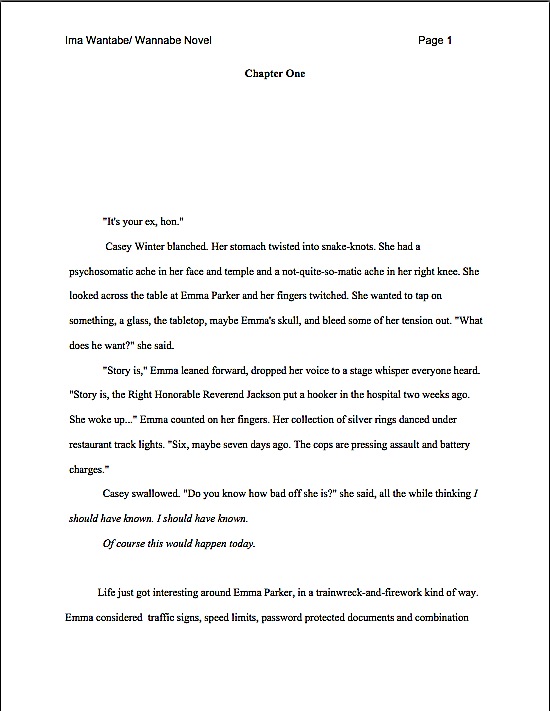
Whereas what Millicent is likely to see for evaluation purposes is this:
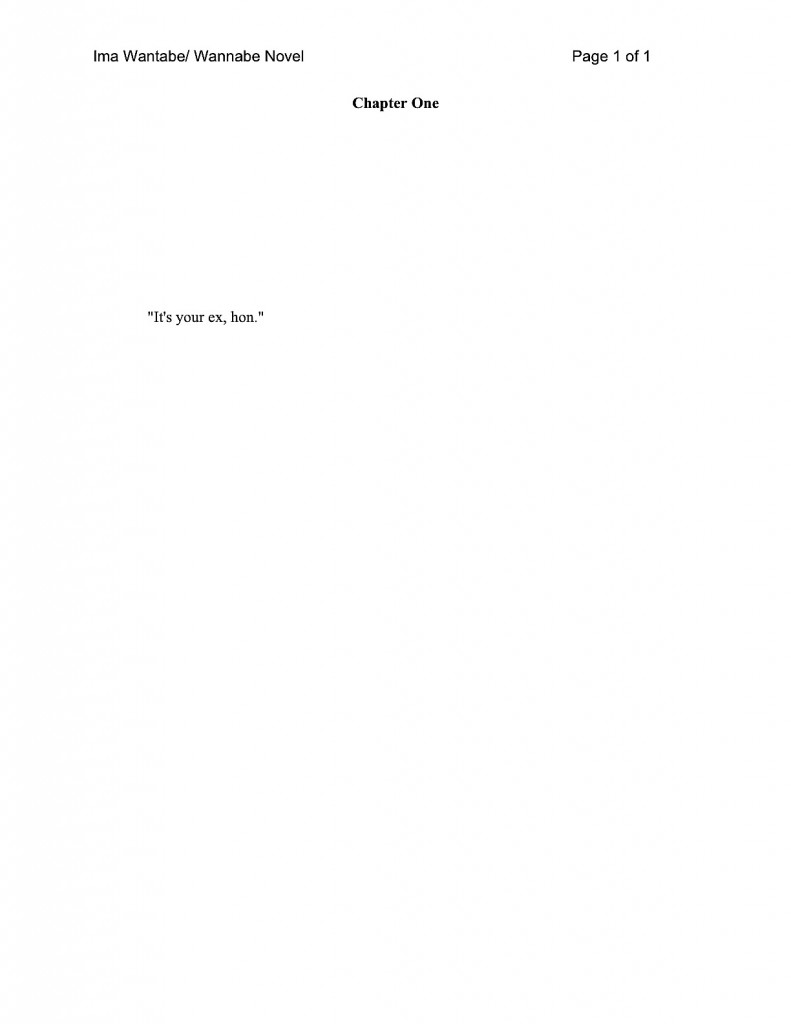
What makes me think she might choose to stop reading at that point — and not, say, immediately after spotting the unusual slug line or odd pagination? As I mentioned earlier in this series, small formatting errors are seldom instant rejection triggers; presentation gaffes may affect how seriously Millicent reads the text (see my earlier comment about how much more time-consuming it is for an agent to represent a client who doesn’t know the self-editing ropes), but it’s rare that she would dismiss it entirely on cosmetic grounds alone.
She may reasonably be expected to read what follows with an a slightly jaundiced eye, though, if not an outright expectation that the writing will not be polished up to professional standards. Which is precisely what happens in our example: manuscripts that open with unidentified speakers are a notorious Millicent pet peeve.
Actually, cutting the narrative off here gives us a sterling insight into why. Take a gander at the first sentence (and first paragraph) of this manuscript, forgetting that you know anything about the story to follow:
“It’s your ex, hon.”
What does it tell us, stripped of context? We already established last time what this opening doesn’t tell us: who the speaker is. Or who the listener is, for that matter, beyond the fact that s/he has evidently participated in a relationship prior to the beginning of the story. It also doesn’t tell us whether the speaker or the hearer whether is male or female, anything about his/her tone, what the environment is like, the speaker’s motivation in bringing this information to the listener’s attention…
We don’t even know how crucial this statement is to the actors, whether it’s the key to the story to come or merely one line of dialogue amongst many. Standing alone, this speech could serve equally well in the mouth of a bored operator transferring the thirtieth perfectly mundane call from a civil ex and coming from the lips of a horrified onlooker who has just spotted an axe murderer standing behind her best friend.
Even more serious from Millicent’s perspective, it also doesn’t really give us any hit about who the protagonist is or what conflict s/he faces — which are, lest we forget, questions that she fully expects a well-written page 1 to answer, at least provisionally. While naturally, it would be a tad unreasonable to expect the first paragraph of a manuscript to answer both of those questions (which form, presumably, the basis for a 350-page book), is she so wrong to expect that first paragraph to whet her appetite about the story to come?
Bearing all that in mind, let me ask you: in Millicent’s shoes, would you keep reading?
A forest of hands just shot into the air. Yes — you in front? “I wouldn’t keep reading,” an inveterate conference-goer points out, but not because I was confused about who was saying the speech, or because I was not sufficiently intrigued by it as conflict introduction. No, if I were Millie, I would have stopped reading as soon as my gaze hit that first set of quotation marks: I’ve heard agents say at conferences/in interviews/on their blogs that they just don’t like to see manuscripts open with dialogue on the first line.”
I’ve heard this one from time to time, too. Usually, one agent sitting on a panel will begin a critique with, “Maybe it’s just me, but I don’t like to see dialogue in the first line.” Almost invariably, the agent sitting next to him will turn to him and say, “Really”
It’s not a universal pet peeve, in short. As simple observation of the literary world will tell us: a lot of very good books open with dialogue. That being said, I would certainly advise a writer who hears an agent express such an opinion immediately to make a mental note never to send that agent a manuscript that opens with dialogue. That’s just basic prudence.
I know I’ve been saying it a lot lately, but it bears repeating: no matter how much talk there is about how agents all want to represent the same kinds of books, it’s just not the case — they are individuals, with individual tastes. And thus, logically, if your submission is rejected by one, you have most emphatically NOT been rejected by the entire industry: you’ve been rejected by one individual within it.
Learn what you can from the experience, then move on.
Unfortunately, the writer of our ongoing example is quite unlikely ever to find out whether the Millicent who passed on her submission harbored a lingering resentment against opening dialogue, or didn’t like the unattributed dialogue, or indeed, any other actual cause of complaint against the manuscript itself. These days, it’s quite rare for a rejection to contain any concrete reason at all. Most of the time, queries and submissions alike are rejected with the same form letters filled with stock phrases: we’re sorry, but it did not meet our needs at this time; I just didn’t fall in love with this protagonist; I don’t feel I can sell this book in the current market.
Which makes it rather hard to learn much from the rejection experience, admittedly. All an aspiring writer can do is keep pushing ahead, polishing her craft in private, until she finds the right agent. Keeping an eye on what’s been published lately in her chosen book category can’t hurt, either.
Yes, persistent hand-raiser off in the corner? “Okay, Anne, I understand both that it’s a good idea to avoid opening a manuscript with an unattributed piece of dialogue, and that since there are a few agents out there who will reject submissions with dialogue in their first lines, attributed or not, I cannot please all of the people all of the time if I want to keep my initial dialogue. But let’s say that I just love my opening quote, and I’m willing to trust my luck that it will land on the desk of someone who doesn’t hate initial dialogue. How would you suggest I present it without running afoul of your second critique from last time, over-using tag lines? Or, to take advantage of our ongoing example, how would you suggest changing it to be more appealing to Millicent?”
Ooh, that’s a tough question, persistent hand-raiser. As you point out, the easiest way to correct the first problem would be simply to add a tag line, identifying the speaker:
“It’s your ex, hon,” Emma said.
It’s not a very creative solution, though; it neither adds much interest to the paragraph nor gives the reader much insight into who Emma is, what her primary conflict might be, etc. Also, this approach might be problematic if Casey turns out to be the protagonist — as, indeed, Millicent would have assumed from the original submission.
And why would she have leapt that conclusion, you ask wearily? The same answer as before: selective reading. Here’s the point in the text where she would have made up her mind on the subject:
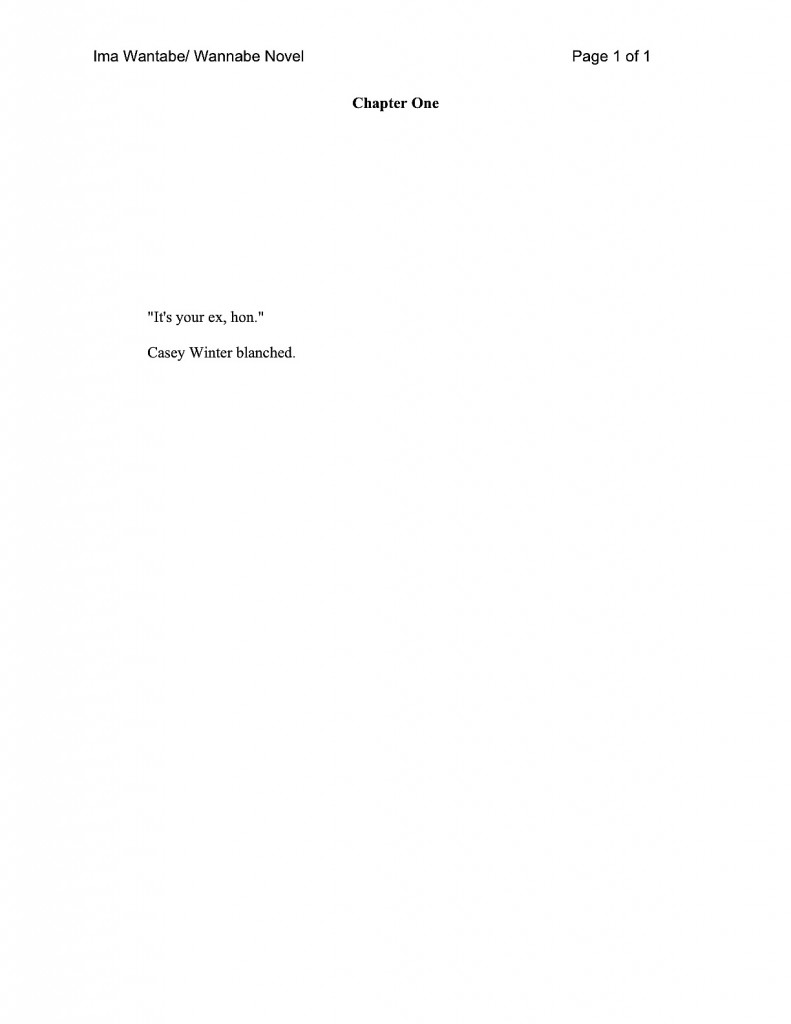
Generally speaking, Millicent will assume the first named character on page 1 of a novel to be the protagonist until proven otherwise — especially if that character is the most active one in the opening scene. Since she doesn’t always appreciate being informed later in the text (or even on the page) that she was wrong about that, you might want to construct your opening scene accordingly.
Let’s assume for the sake of example, though, that Emma, and not Casey, is the protagonist, since it’s entirely possible that this was the author’s intended implication by having her speak first. (At least I assume that it is Emma who speaks first in this scene, rather than someone in the background.) What our exemplar’s quickest revision options for steering a middle course between no speaker identification in the first paragraph and applying tag lines indiscriminately?
Why quickest, you ask? Oh, you’ve never caught a manuscript problem ten minutes before you were about to stuff it into an envelope — or two minutes before hitting the SEND button? Lucky you.
No, but seriously, folks, it’s been my experience that once an opening scene hits a page, many, if not most, aspiring writers are rather reluctant to change its structure or even its wording much. Writers can get extremely attached to their opening sentences and paragraphs; even those tinker endlessly with mid-book phraseology are often downright defensive about their initial scenes.
We all imagine future browsers lovingly pulling our books off shelves years hence, you see, sitting down to devour our first pages at a glance. Who wants some third party, even one as advantageously placed to help you get your book published as Millicent, to dictate the first impression we will make on our as-yet-unborn fans?
Back to the problem at hand. Identifying the speaker in a separate sentence within the first paragraph is the method most editors would suggest, as it provides ample opportunity for providing context for an opening comment, giving characterization hints, introducing the protagonist as active, and so forth.
It’s also, if you play with the running order a little, a dandy way to side-step the perils of running afoul of opening-dialogue-hating agents. You simply have the narrative sentences come first.
What might this look like in practice? Instead of simply using a tag line to identify the speaker, like so:
“It’s your ex, hon,” Emma said.
The reviser could add some action to the opening — ideally, action that sets the tone for the scene to follow. Since the line of dialogue follows immediately thereafter, the direct implication is that the primary actor in the first paragraph is also the speaker.
Emma dodged the knife-wielding maniac, escaped, panting, down the hallway, and collapsed at her best friend’s usual lunch table. “It’s your ex, hon.”
No doubt about who is speaking there, eh? Or that the protagonist is an interesting person in an interesting situation?
Beefing up a dialogue-bearing opening paragraph can also provide a great opportunity to introduce physical characteristics of both protagonist and place. Be careful in what you choose to put here, though — mundane descriptors tend to imply rather ordinary protagonists. Telling details, however, can be worked in beautifully. Borrowing from lower on our example page:
Emma’s collection of silver rings danced under restaurant track lights. “It’s your ex, hon.”
I see a few more raised hands waving frantically at me. “But Anne, the reason I’m starting my manuscript with a piece of dialogue is that I feel that the spoken words themselves are important — so much so that I genuinely like seeing them all alone at the top of the page, as in the example. What you’re suggesting seems to water down their impact a little. Couldn’t I just, you know, add a tag line with an adverb attached, providing enough information that Millicent won’t jump down my throat, but still preserving the opening sound that I like?”
Well, you could, oh frantic ones, if you minimized the tag lines throughout the rest of the scene AND you happen not to be writing in a book category where tag lines are positively to be avoided (literary fiction, for instance, eschews them to a remarkable extent). If the initial statement is crucial to the scene — as it should be, if you’re opening with it; as in a screenplay, the first thing the protagonist says in the book sets up the reader’s idea of what kind of a person she is — it might well make sense to highlight a particularly startling statement that reveals character or conflict in a surprising or original manner.
In other words, don’t try it with an everyday statement; it’s probably not worth the risk.
If you’re going to incorporate a tag line in the first sentence of your book, make sure it pays off. There’s just no getting around the fact that adding a tag line might not pass muster with a Millicent who believes that tag lines are always avoidable (as they almost invariably are, with some rhetorical gymnastics), but if you feel that it’s the best means of kicking off a conflict, go a head and give it a try. It helps if you choose an interesting speaking verb, instead of the prosaic and ubiquitous said:
“It’s your ex, hon,” Emma spat, slamming her tray down on the tiny, slick table.
Casey Winter blanched. Her stomach twisted into snake-knots…
You want to read on, don’t you? That’s because these initial lines jump straight into a conflict. (One that I have no reason to believe exists in the manuscript as it is currently written, but work with me here.)
Still, it wouldn’t be all that difficult to maintain a similar energy while trimming the tag line. Implication is the writer’s friend, after all.
Emma swerved her way through the crowd of tray-wielding lunchers, slamming her tray down loudly on Casey Winter’s table. Gossip boiled in her system, and she could hold its hot fire inside no longer. “It’s your ex, hon,”
Casey blanched. Her stomach twisted into snake-knots…
Up go those hands again. “But Anne, what if Casey, and not Emma, is the protagonist? How would you suggest revising the opening then?”
That’s a good question, talking hands — frankly, in that case, I would be reluctant to allow Emma to speak first. I would be easy enough to move the content of the initial piece of dialogue into her mouth, after all. I would, however, trim her reactions so that they all take place inside of her (as opposed to blanching, something Emma might see from the outside), to ramp up the intensity of the opening:
“My ex?” Casey Winter’s stomach twisted into snake-knots. She had a psychosomatic ache in her face and temple and a not-quite-so-matic one in her right knee. She wanted to tap on something, a glass, the tabletop, maybe Emma Parker’s skull, and bleed some of her tension out. “What does he want?”
Emma leaned forward…
My overarching point, should you care to know it: good revision — on the stylistic front, at least — is less about applying hard-and-fast rules than making choices. Nowhere is that more true than on page 1 of your manuscript, for once a reader gains an impression of your protagonist (even if it’s an incorrect one), that’s going to inform how he responds to the rest of the book.
Page 1, in essence, is your story’s introduction to the world. How do you want it to appear?
And, of course, Millicent’s decision whether to keep reading or reject is based entirely on page 1, necessarily. She will be deciding line by line, sentence by sentence, whether to push on or reach for the form-letter rejection pile.
At the submission stage, then, there’s no such thing as a throwaway line on page 1 — or page 2, or page 15, or in the first 50 pages. Grabbing and keeping the attention of as nit-picky a reader as Millicent requires not only telling a good story well, but also paying attention to the details.
Practically nothing escapes her notice, you know. But isn’t that ultimately a very gratifying reader to have for your work, one who notices and appreciates all of your fine work, all of your intelligent choices?
Sort of strange to think of ol’ Millie in that light, isn’t it? Give it a ponder — and, of course, keep up the good work!






